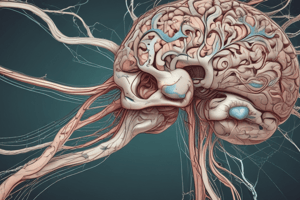Podcast
Questions and Answers
What is the basic division of the nervous system?
What is the basic division of the nervous system?
- Central nervous system and autonomic nervous system
- Central nervous system and peripheral nervous system (correct)
- Central nervous system and neuromuscular system
- Central nervous system and peripheral circulatory system
What is the typical shape of the nerve cell bodies in autonomic ganglia?
What is the typical shape of the nerve cell bodies in autonomic ganglia?
- Pseudo unipolar
- Bipolar
- Stellate multipolar (correct)
- Rounded cell body with central nucleus
What is the structural and functional unit of the nervous tissue?
What is the structural and functional unit of the nervous tissue?
- Nerve processes
- Nerve cells (correct)
- Neuroglia
- Nerve fibers
What is the characteristic of the capsule in autonomic ganglia?
What is the characteristic of the capsule in autonomic ganglia?
What is the function of dendrites in a nerve cell?
What is the function of dendrites in a nerve cell?
What is characteristic of the axon?
What is characteristic of the axon?
What is characteristic of the cell body of a nerve cell?
What is characteristic of the cell body of a nerve cell?
What is the arrangement of nerve cells in autonomic ganglia?
What is the arrangement of nerve cells in autonomic ganglia?
What is present in the cytoplasm of the cell body?
What is present in the cytoplasm of the cell body?
What is the characteristic of synapses in autonomic ganglia?
What is the characteristic of synapses in autonomic ganglia?
What is unique about the mature nerve cell?
What is unique about the mature nerve cell?
What type of nerve fibers are present in autonomic ganglia?
What type of nerve fibers are present in autonomic ganglia?
Where are autonomic ganglia typically located?
Where are autonomic ganglia typically located?
What may cover the axon?
What may cover the axon?
What is the shape of the cell body of a bipolar neuron?
What is the shape of the cell body of a bipolar neuron?
Which type of neuron has a single long axon and multiple short dendrites?
Which type of neuron has a single long axon and multiple short dendrites?
What is the function of the nerve fiber in spinal ganglia?
What is the function of the nerve fiber in spinal ganglia?
What is the characteristic of a pseudo-unipolar neuron?
What is the characteristic of a pseudo-unipolar neuron?
What is the site of cerebro-spinal ganglia?
What is the site of cerebro-spinal ganglia?
What is the characteristic of a pyramidal neuron?
What is the characteristic of a pyramidal neuron?
What is the structure of a ganglion?
What is the structure of a ganglion?
What is the characteristic of the nerve cell bodies in spinal ganglia?
What is the characteristic of the nerve cell bodies in spinal ganglia?
Flashcards are hidden until you start studying
Study Notes
Nervous Tissue
- Nervous tissue is one of the basic tissues of the body, dividing anatomically into the central nervous system (brain and spinal cord) and peripheral nervous system (nerves and ganglia).
- Histologically, it divides into nerve cells (neurons) and neuroglia.
Structure of Nerve Cells (Neurons)
- A nerve cell (neuron) is the structural and functional unit of nervous tissue, consisting of a cell body (perikaryon), nerve processes (axon and dendrites), and cell inclusions.
Cell Body (Perikaryon)
- The cell body contains a large, rounded central pale nucleus with a prominent nucleolus.
- Cytoplasm contains RER, scattered basophilic bodies (Nissl's granules), Golgi apparatus, mitochondria, lysosomes, SER, neurotubules, and neurofilaments.
- The mature nerve cell has no centrosome, so it cannot divide.
Dendrites
- Dendrites are multiple, short, and thick processes branching along their course.
- They have irregular surfaces and diameters.
- Dendrites conduct nerve impulses towards the cell body and contain all organelles except Golgi, including Nissl granules.
Axon
- The axon is a single, thin, and long process of the cell body.
- It has a regular surface and diameter.
- The axon branches at its terminal end, forming axon terminals.
- Its cytoplasm contains most organelles, but no Golgi or Nissl granules.
- The axon may be covered by a myelin sheath and transmits nerve impulses away from the cell body.
Types of Neurons
- Unipolar neurons have one process, found in invertebrates.
- Pseudo-unipolar neurons have one process that divides into two branches, found in cells of spinal ganglia.
- Bipolar neurons have a fusiform cell body with two processes, one acting as an axon and the other as a dendrite, found in the olfactory epithelium, retina, and inner ear.
- Multipolar neurons can be:
- Stellate neurons with multiple short dendrites and a single long axon, found in sympathetic ganglia and anterior horn cells.
- Pyramidal neurons with a pyramidal shape, multiple dendrites, and a single axon, found in the cerebral cortex.
- Pyriform neurons with a flask shape, multiple dendrites, and a single axon, found in Purkinje cells of the cerebellum.
Ganglia
- A ganglion is a collection of nerve cell bodies outside the central nervous system.
Types of Ganglia
- Cerebro-spinal ganglia:
- Located in cranial and spinal sensory nerves.
- Structure: thick CT capsule surrounds each ganglion, with pseudo-unipolar neurons arranged in groups or rows, surrounded by satellite cells, and thickly myelinated nerve fibers.
- Synapses: absent.
- Autonomic ganglia:
- Located along sympathetic and parasympathetic nerves.
- Structure: thin capsule, with stellate multipolar neurons, surrounded by few satellite cells, and unmyelinated nerve fibers.
- Synapses: present.
Studying That Suits You
Use AI to generate personalized quizzes and flashcards to suit your learning preferences.




